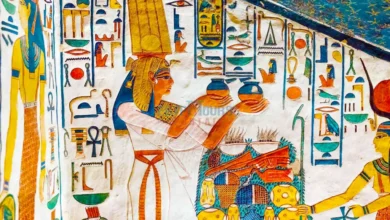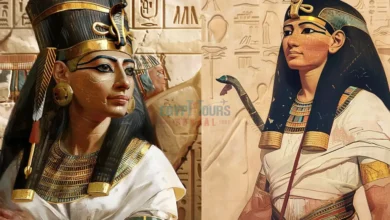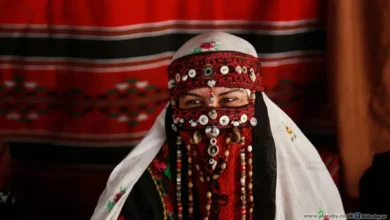Meta Description: From the elegant linen sheaths of the pharaohs to the vibrant modern Galabeya, explore the rich history and evolution of traditional women’s clothing in Egypt and its deep cultural symbolism.
Egyptian women’s fashion
The story of Egypt is a story told in stone, papyrus, and thread. While the pyramids and temples speak of its eternal power, the clothing worn by its women reveals a more intimate narrative—one of identity, status, faith, and resilience. For millennia, the garments of Egyptian women have been a canvas upon which their roles in society, their personal tastes, and the shifting tides of history have been painted.
From the deceptively simple linen dresses of antiquity, designed for a life lived under the sun, to the intricately embroidered robes of today, women’s fashion in Egypt has been a dynamic interplay of practicality, elegance, and symbolism. It is a story of how a culture maintains its core identity while absorbing and reinterpreting influences from across the world.
In this journey through time, we will explore:
✅ The iconic garments of ancient Egyptian women and their symbolic meanings.
✅ The influence of Roman, Coptic, and Islamic traditions on female attire.
✅ The vibrant diversity of rural and urban dress in the 19th and 20th centuries.
✅ The role of the Galabeya and the Hijab in modern Egyptian women’s fashion.
✅ How contemporary designers are breathing new life into traditional styles.
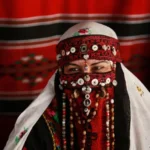 Traditional Clothing of Egypt: A Timeless Blend of Heritage and Culture
Traditional Clothing of Egypt: A Timeless Blend of Heritage and Culture
Prepare to unveil the wardrobe of the Egyptian woman, a collection as rich and enduring as the land of the Nile itself.
👑 Antiquity (c. 3100 BC – 30 BC): The Elegance of Linen
The clothing of ancient Egyptian women was a masterpiece of minimalist design, perfectly suited to the hot, dry climate. The primary material was linen, derived from the flax plant. The quality of the linen, from coarse to almost transparently fine, was a direct indicator of social status.
The Kalasiris: The Iconic Sheath Dress
- Description: The most recognizable garment of this era was the Kalasiris, a simple sheath dress. It was a long, form-fitting tube of fabric that began just under the bust and extended to the ankles, held up by two shoulder straps.
- Symbolism and Function: While it appears restrictive in ancient art, the Kalasiris was likely made of stretchy, flexible linen, allowing for freedom of movement. Its form-fitting nature celebrated the female form, which was not seen as something to be hidden. Purity was paramount, and the predominant color was white, symbolizing light and sanctity.
- Evolution: In the New Kingdom, the style evolved. Dresses became more elaborate, with pleated fabric, flowing sleeves, and often a second, diaphanous robe worn over the top. Queens like Nefertiti and Cleopatra were depicted in these more luxurious, layered styles, sometimes with intricate beadwork or dyed fabrics in blue, red, and yellow.
Jewelry and Cosmetics: The Finishing Touches
- Clothing was often a simple canvas for elaborate decoration. Women of all classes wore jewelry. The wealthy adorned themselves with collars of gold, lapis lazuli, and carnelian, while commoners used faience (a type of glazed ceramic), shells, and stone.
- Kohl eyeliner and green malachite eyeshadow were universal. They were not just for beauty; they were believed to have magical protective powers and to ward off eye infections.
✝️ Roman and Coptic Era (c. 30 BC – 641 AD): A Fusion of Styles
With Egypt’s incorporation into the Roman Empire and the subsequent rise of Christianity, women’s fashion began to change, reflecting new cultural and religious values.
- The Tunic: The Roman-style tunic (tunica) became common. It was a looser, more modest garment than the Kalasiris, often with sleeves. It was made of linen or wool.
- Coptic Influence: As Christianity spread, the emphasis on modesty increased. The Coptic tunic was often decorated with intricate woven or embroidered panels called clavi (stripes) and orbiculi (roundels). These decorations were not just ornamental; they depicted Christian symbols, biblical scenes, or protective motifs.
- Color Symbolism: While linen remained popular, colors took on new Christian meanings. Purple, once a symbol of Roman imperial power, was adopted by the Church to signify royalty and divinity.
🌙 The Islamic Era (c. 641 AD – 1800s): Modesty and Rich Embellishment
The arrival of Islam brought a profound and lasting shift in women’s attire, emphasizing full coverage and modest silhouettes. The focus of ornamentation moved from the body itself to the fabric and embroidery of the garments.
See also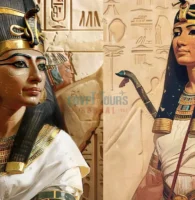 👑🐍🏺 Ancient Egyptian Fashion: A Journey Through Its Evolution and Historical Legacy
👑🐍🏺 Ancient Egyptian Fashion: A Journey Through Its Evolution and Historical Legacy
The Rise of the Galabeya and Outer Wraps
- The Galabeya: The loose, comfortable, and all-covering Galabeya became the foundational garment for women. At home, it was often made of colorful, printed cotton.
- Outdoor Attire: When in public, women would wear a wide, dark-colored outer wrap over their home clothes. In urban areas, this was often the milaya-leff, a large black rectangular cloth skillfully wrapped around the body and head. In rural areas, it was a simple black Galabeya baladi.
- The Veil: The covering of the face and hair became more common, especially among the urban upper classes. The yashmak was a type of veil made of two pieces of muslin, covering the lower face, while the hair was covered by a separate headscarf.
The Art of Embroidery (Tatreez)
- With the body covered, a woman’s creativity, skill, and regional identity were expressed through embroidery. Dresses, veils, and headscarves were adorned with intricate cross-stitch patterns.
- Regional Identity: The colors and motifs of the embroidery could signify a woman’s village, her marital status, and her wealth. The red, geometric patterns of the Sinai Bedouins are very different from the floral designs of the Nile Delta.
🌍 The 19th and Early 20th Century: A Tapestry of Regional Diversity
This period was a high point for the diversity of traditional rural dress. Before mass-produced clothing became common, each region of Egypt had its own distinct style of women’s clothing.
- Fellahin (Farmers) of the Delta: Women wore a dark, often blue or black, cotton Galabeya for work. For festive occasions, they wore brightly colored dresses, sometimes layered, and adorned with coins and beads.
- Siwa Oasis: The women of Siwa are famous for their unique bridal costumes, heavily embroidered with mother-of-pearl buttons, beads, and colorful silk threads. The dresses are voluminous and worn with a distinctive silver headdress.
- Nubian Women (Southern Egypt): Nubian women traditionally wore a semi-transparent, often black, outer garment called a gergar over a colorful dress. The transparency was a stylistic choice, creating an elegant, layered look. Their jewelry, including large gold earrings and nose rings, was a key part of their attire.
🏙️ The Modern Era (Mid-20th Century to Present): Urbanization, Westernization, and Islamic Revival
The 20th century brought rapid and complex changes to Egyptian women’s fashion.
Westernization and the Urban Elite
- In the early to mid-20th century, the urban upper and middle classes in cities like Cairo and Alexandria largely adopted Western fashion. Dresses, skirts, and blouses became the norm, and traditional attire was often seen as rural or outdated.
The Enduring Galabeya
- Despite the prevalence of Western clothes, the Galabeya never disappeared. It remained the primary garment in rural areas and became the universal “at-home” attire for women of all classes. It is the ultimate garment of comfort and domestic life. Modern home Galabeyas are made in a dazzling array of colors and prints, from soft cotton to plush velvet for winter.
The Rise of the Modern Hijab
- Beginning in the 1970s, a new Islamic revival movement brought the hijab (headscarf) back to prominence, not as a traditional folk custom, but as a modern expression of religious identity.
- This was not a return to the old yashmak or milaya-leff. The modern hijab is a versatile fashion item. Young women style it in numerous creative ways, coordinating colors and fabrics with their (often Western-style) outfits. This has given rise to a huge “modest fashion” industry, with designers creating stylish, long-sleeved tops, flowing skirts, and elegant coats designed to be worn with the hijab.
The Modern Synthesis
- Today, the wardrobe of an Egyptian woman is a fascinating synthesis. She might wear jeans and a t-shirt to the university, a formal suit to her office, a beautiful Galabeya at home with her family, and a stylish, modern hijab-compliant outfit for a social evening. Each choice of clothing is a reflection of the different facets of her identity in the modern world.
Conclusion: A Wardrobe of Resilience and Identity
The evolution of women’s clothing in Egypt is a mirror of the nation’s soul. It reflects a history of adaptation, a deep connection to tradition, and a remarkable capacity for creative synthesis.
From the sacred white linen of the pharaonic priestess to the colorful home Galabeya and the chic, modern hijab, the garments have changed, but their core purpose has not. They have always been a way for women to navigate their world with dignity, express their identity, and carry their heritage on their shoulders.
The Egyptian woman’s wardrobe is not a single look, but a rich and varied collection, allowing her to choose, adapt, and express who she is—a daughter of the Nile, a citizen of the modern world, and the keeper of a legacy woven in thread.
